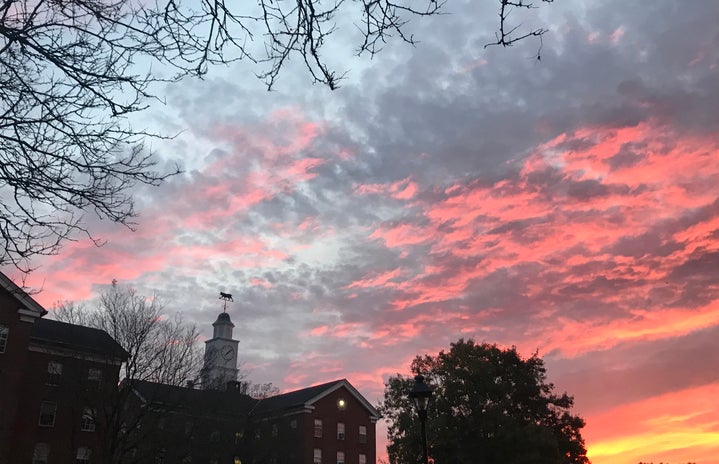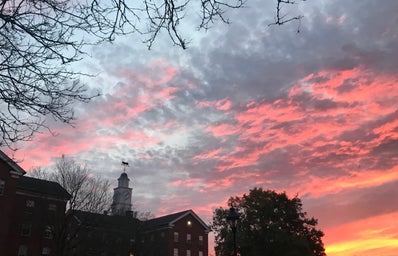I never ventured outside to see the media vans parked conspicuously outside of my dorm building on the few days following December 11. At the time, I was extremely stressed about completing a research paper on time. As twilight rimmed the edges of the sky outside my window, I was unaware that something unspeakable had just happened just a few blocks away from me. Little did I know that it would supersede the adrenaline-fueled anxiety I was feeling right before the much dreaded exam week.
I found out about it when I was taking a study break, manically scrolling through my phone, seeking some semblance of escapism. A tribute to Tessa Majors flashed on my screen with a picture of a green-haired girl with a wide smile. She was a Barnard freshman from Charlottesville, Virginia, with an up and coming band, Patient 0, that had just released their first album. Fresh-faced and youthful, Tessa was an ambitious young girl with many dreams and a whole life ahead of her.
In a statement, President Sian Beilock shared Tessa’s response to a question in her application to Barnard. Tessa wrote, “As an avid feminist, I have striven towards bridging my community gender divide by being outspoken in my classes, taking an intensive course on social justice, and campaigning for a congressional candidate. I enjoy taking difficult classes and feel invigorated when forced outside of my intellectual comfort zone. I embrace the culture of positivity and growth at Barnard.” This was a girl who was immensely excited to live in the city and experience new things. She was a girl I could see in myself, a newcomer in a somewhat strange city with hopes for the future. However, reality can sometimes be worse than fiction.
On December 11, Tessa Majors was walking through Morningside Park around 7pm when she was approached by three males. They proceeded to stab her multiple times after they attempted to steal her belongings in a struggle. She attempted to walk up the multiple sets of stairs, and collapsed after reaching the top in Morningside Heights where she was found by a campus security officer. She was pronounced dead once she was transported to Mount Sinai Hospital.
Like many others in the Barnumbia community and beyond, I struggled to wrap my head around Tessa’s passing. On Tessa’s Instagram, my friends and peers were commenting in solidarity sending their condolences and prayers her way. Multiple emails from Barnard and Columbia filled my inbox discussing her death and its tremendous impact on the community. Hushed whispers filled the hallways as my peers tacitly mentioned her death in passing, tacitly avoiding discussing the issue head on. Bouquets of flowers were placed on top of the Barnard insignia in a silent act of mourning. President Beilock hosted an event where students and faculty could come together to discuss the tragedy as a collective.
Even now, I can say that the passing of Tessa Majors is still a highly controversial topic on multiple fronts. Most public discourse and articles have not adequately addressed the underlying issues that have reared their heads in the aftermath. In this piece, I will try my absolute best to address these from my perspective in a manner that is empathetic to Tessa and sensitive to the needs of a community that is still in the process of healing from such an appalling tragedy.
In the subsequent days after Tessa’s passing, many blamed campus security for their untimely and inadequate response when she was found near a security outpost with fatal wounds. It is said that they should have had another guard posted by Morningside Park while the campus security officer was making rounds. Possibly, if a guard had been at the post where Tessa collapsed, she may have been alive today instead of being found half an hour later, motionless. In any tragedy, one’s mind ruminates over the million possibilities and what-ifs. It’s only human. But doing so leaves us stuck in the past — in a quandary that is difficult to surmount.
Looking at the big picture, while campus security needs to be improved, this is also an issue of the city. Besides the obvious — increasing NYPD presence near the park — more needs to be done about repairing Morningside Park and its image. Most residents living near the park know it as a place where drugs are dealt and thefts occur. More lights need to be installed within the park as it is often dark in many parts during the night. Countless more improvements could be made to the park as well. I am no expert or policymaker, but the apparent neglect of the park is most definitely a factor that can contribute to increase safety in Morningside Heights and Harlem.
These two disparate neighborhoods bring me to the elephant in the room most people have avoided addressing. Race. What does race have to do with Tessa Majors? Absolutely everything. The community and national media’s immediate response to the death of a white college girl made me think of all the poorer women of color whose lives and deaths frequently go unnoticed. We are always told that all lives matter equally. But in the eyes of a racially and gender-biased system is that really true? We are willing to empathize with a college-bound white girl because she is more relatable to us than the Black trans woman from Harlem who is struggling to make ends meet with sex work. We don’t mean to think this way, we have just been unconsciously programmed to value the lives of some more than others based on their place in the system undergirded by class, gender and racial structures.
The details of Tessa Major’s death do not even end there. A disturbing aspect of it all is the age of the assailants. Although most of us are not willing to admit it, they were from Harlem, which informally is code for African-American. These are the kind of conjectures individuals make through no fault of their own, but of the system of whose ideas they have been inculcated with. They were adolescent boys, between the ages of 12 and 15. They were probably desperate for a couple of bucks, and when they saw an affluent white girl walking alone in Morningside Park, they seized their opportunity. I am not justifying Tessa’s tragic death in any way whatsoever; her life was taken from her suddenly and unfairly. But I also see the importance of understanding the other’s perspective, even if it is convoluted and something I would never condone.
Additionally, one of the boys, a 13-year-old has been arrested and charged in connection to Tessa’s murder. Apparently, he confessed without the presence of an attorney after police interrogation which is concerning enough. The possibility that this child was not aware of his full rights as a citizen speaks to the inadequate representation that Black people receive based on stratifications articulated within the institutional criminal system. Fair and just treatment and representation in the legal system is paramount to families of victims receiving justice. I argue that it is essential for victims like Tessa Majors to have their crimes prosecuted properly, and that the persons who have actually committed the crime are apprehended.
Morningside Park delineates the fractured divide between residents of Morningside Heights and Harlem. The communities in these two neighborhoods have always existed next to each other but almost never interact with each other. A coming together of these two communities is needed if we are to make any sense of Tessa Major’s passing. Coexistence is necessary to heal the wounds of trauma.
As individuals, the only thing we can do is keep ourselves safer. We can utilize campus security resources at night when we feel unsafe, and keep pepper spray on hand. We can take self-defense courses, and be alert for crimes that are occurring in the city through apps like Citizen, which notifies you when a crime or accident is occurring in real time. Walking in pairs or groups at nights in more isolated streets and in the park is also key. However, what we must also realize is that the inevitable is the inevitable. We cannot fully prevent what we do not know — what will happen in the future.
Be vigilant, but also be aware that everything is not always what it seems. A tragedy contains multitudes. Facts, statistics, claims, and aftereffects of Tessa’s death will always confront us. As individuals and as a community, it is up to us to discern the full complex truth of this tragedy, to let it teach us a lesson, and to allow it to inform us about the future.


